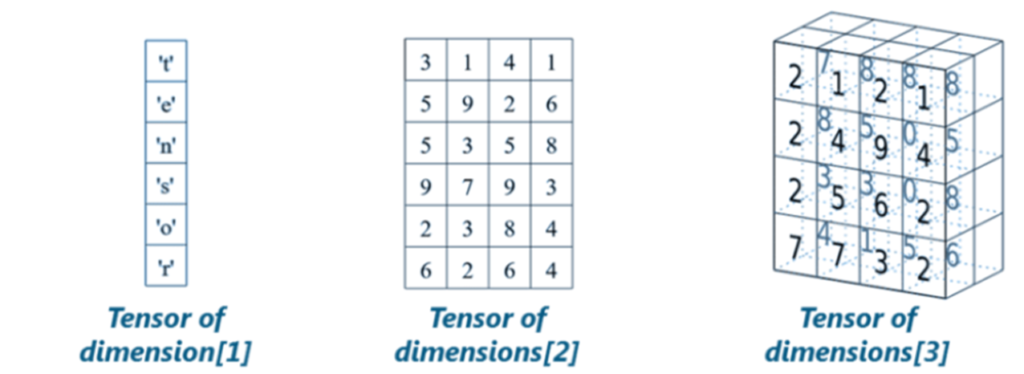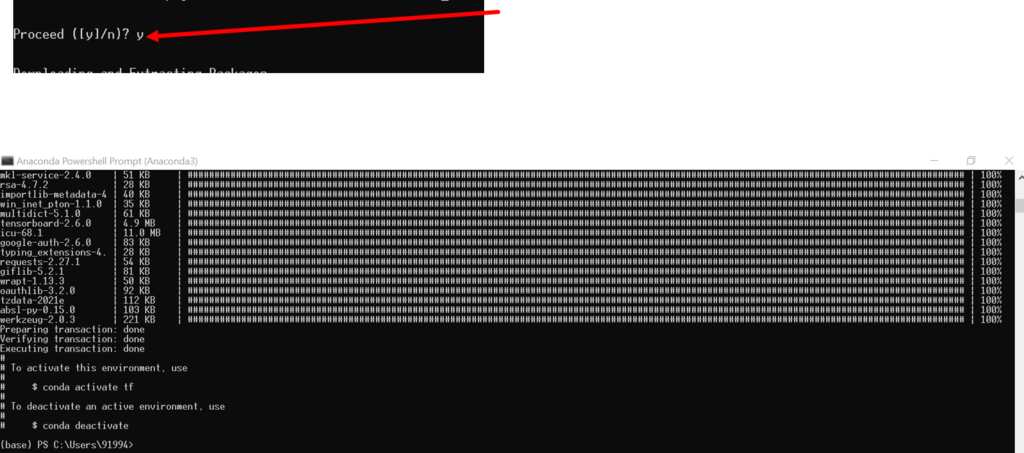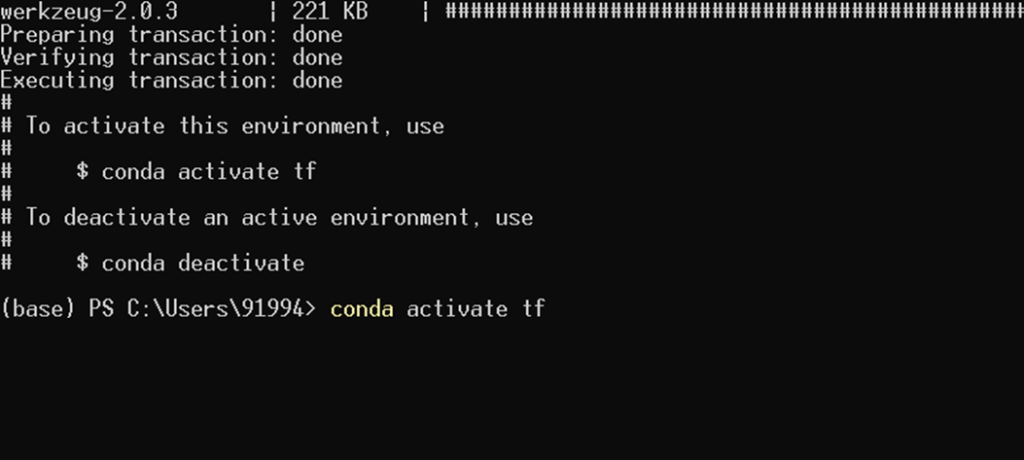Tensor Flow
Tensors
de facto for representing the data in deep learning


- Tensors are just multidimensional arrays, that allows you to represent data having higher dimensions.
- Tensor Flow is a library based on Python that provides different types of functionality for implementing Deep Learning Models
- Tensor Flow is made up of two terms – Tensor & Flow

Tensor Attributes
TensorFlow API
Basic Notations
Node:
- A node represents an operation, possibly applied to some input and can generate an output that is passed on to other nodes
- Example: a = matmul(x,w).
- Here matmul() is a node
- Note: Nodes can be calculated by using session object
Edges / Tensor objects
- A graph has to be created before calling the session object
- The computed result can be passed on flow to another node while creating the graph
- These references, are called Edges / Tensor objects
Session()
- Session() helps in the execution of the Computational graph and controls the state of the tensorflow runtime
- Without Session, it is not possible to execute tensorflow programs
Draw the graph
a(b, c, d) = (b + c) * (d - 4)
x = (b + c)
y = (d - 4)
a = x * y
Determine Rank
Ranks
- Tensor ranks are the number of dimensions used to represent the data. For example:
Rank 0 – When there is only one element. We also call this as a scalar.
- Example: s = [2000]
Rank 1 – This basically refers to a one-dimensional array called a vector.
- Example: v = [10, 11, 12]
Rank 2 – This is traditionally known as a two-dimensional array or a matrix.
- Example: m = [1,2,3],[4,5,6]
Rank 3 – It refers to a multidimensional array, generally referred to as tensor.
- Example: t = [[[1],[2],[3]],[[4],[5],[6]],[[7],[8],[9]]]
Installation without command Prompt
Step 1: Search the installation

Step 2: Installation of package

Step 3: Display of dependency package

Step 4: Installation status

Step 5: Completion of installation

Installation with command Prompt
Step 1: In the start menu, select Anaconda Powershell Prompt (Anaconda 3)

Step 2: Type the command conda create –n tf tensorflow And press enter

Step 3: Give y

Step 4: Type conda activate tf and press enter

Step 5: Finally, the screen will look like this

Writing a Tensor Flow Program
The process involves two steps:

Building a Computational Graph
- A computational graph is a series of Tensor Flow operations arranged as nodes in the graph
- Each nodes take 0 or more tensors as input and produces a tensor as output
- Example: Computational Graph with three nodes a, b and c

Running a Computational Graph
- To get the output of node c, run the computational graph within a session
- Session places the graph operations onto devices, such as CPUs or GPUs and applies methods to execute them
- A session encapsulates the control and state of the TensorFlow runtime i.e. it stores the information about the order in which all the operations will be performed and passes the result of already computed operation to the next operation in the pipeline
Data types
Constants
Constants are used to create constant values
tf.constant(value,
dtype = None,
shape = None,
name=‘Const’
verify_shape = False)S = tf.constant(2, name=‘scalar’)
M = tf.constant ([ [1,2], [3,4] ], name = ‘matrix’)Creating constants
import tensorflow as tf
with tf.compat.v1.Session() as s:
#Build Computational Graph
a = tf.constant(5)
b = tf.constant(6)
c=tf.add(a,b)
#Run the graph using session object and store the output in a variable
result = s.run(c)
#Print the output of node
print("result=",result)
#Close the session to free up some resources
s.close()result= 11Variables
Variables are stateful nodes which output their current value. They can be saved and restored
Example
tf.get_variable( name, shape = None, dtype = None, initializer = None)S1 = tf.get_variable(name = ‘scalar1’, initializer = 2)
M1 = tf.get_variable(“matrix”, initializer = tf.constant( [0,1], [2,3])with tf.compat.v1.Session() as s:
#create graph
a1 = tf.compat.v1.get_variable(name="A3", initializer = tf.constant([[0,1],[2,3]]))
b1 = tf.compat.v1.get_variable(name="B3", initializer = tf.constant([[4,5],[6,7]]))
c1 = tf.subtract(a1,b1,name = "subtract")
#Initialize variables
init_op = tf.compat.v1.global_variables_initializer()
#Run the graph
s.run(init_op)
print("Result = ", s.run(c1))
Result = [[-4 -4]
[-4 -4]]Placeholder
- Placeholder is a node whose value is fed in at execution time
- Assemble the graph without knowing the values needed for computation
- Later supply the data at execution time
tf.compat.v1.disable_eager_execution() # use this in order to use placeholder()
a = tf.constant([5,5,5],tf.float32, name = "A5")
b = tf.compat.v1.placeholder(tf.float32, shape=[3],name="B5")
c = tf.add(a,b,name = "Add")
with tf.compat.v1.Session() as s:
d = {b:[1,2,3]}
print(s.run(c,feed_dict=d))
[6. 7. 8.]Aggregate Functions
import numpy as np
ten_obj = tf.constant( [ [1,2,3], [-1,0,4], [-4,3,100] ] )
with tf.compat.v1.Session() as s:
#Initialize variables
init_op = tf.compat.v1.global_variables_initializer()
#Run the graph
s.run(init_op)
sum1 = s.run(tf.math.reduce_sum(ten_obj))
mean1 = s.run(tf.math.reduce_mean(ten_obj))
min1 = s.run(tf.math.reduce_min(ten_obj))
max1 = s.run(tf.math.reduce_max(ten_obj))
print('Min:', min1)
print('Max:', max1)
print("sum=",sum1)
print("Mean=",mean1)Min: -4
Max: 100
sum= 108
Mean= 12Tensor Flow Built in Functions
tf.zeros
- Functions for the matrix with all zeros
tf.ones
- Functions for the matrix with all ones
tf.negative
- Function for changing all the values to negative
Mathematical Operations
tf.add(a, b)
tf.subtract(a, b)
tf.multiply(a, b)tf.div(a, b)
tf.pow(a, b)
tf.exp(a)tf.sqrt(a)Views: 3